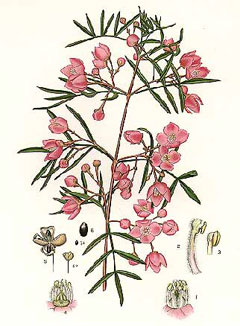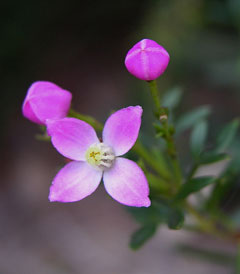 |
|
http://commons.wikimedia.org/wiki/File:Boronia_pinnata-Minchen.jpg |
 |
| http://flickr.com/photos/27834758@N00 |
Translate this page:
Summary
Physical Characteristics

 Boronia pinnata is an evergreen Shrub growing to 2 m (6ft 7in).
Boronia pinnata is an evergreen Shrub growing to 2 m (6ft 7in).
See above for USDA hardiness. It is hardy to UK zone 9. It is in leaf all year. The species is hermaphrodite (has both male and female organs).
Suitable for: light (sandy) soils and prefers well-drained soil. Suitable pH: mildly acid soils. It cannot grow in the shade. It prefers dry or moist soil. The plant can tolerate maritime exposure.
UK Hardiness Map
US Hardiness Map
Synonyms
Plant Habitats
Woodland Garden Sunny Edge; Dappled Shade; South Wall. By. West Wall. By.
Edible Uses
References More on Edible Uses
Medicinal Uses
Plants For A Future can not take any responsibility for any adverse effects from the use of plants. Always seek advice from a professional before using a plant medicinally.
None known
References More on Medicinal Uses
The Bookshop: Edible Plant Books
Our Latest books on Perennial Plants For Food Forests and Permaculture Gardens in paperback or digital formats.

Edible Tropical Plants
Food Forest Plants for Hotter Conditions: 250+ Plants For Tropical Food Forests & Permaculture Gardens.
More

Edible Temperate Plants
Plants for Your Food Forest: 500 Plants for Temperate Food Forests & Permaculture Gardens.
More

More Books
PFAF have eight books available in paperback and digital formats. Browse the shop for more information.
Shop Now
Other Uses
Essential
An essential oil is obtained from the flowers and the leaves[154, 200]. Used in perfumery[200].
Special Uses
Scented Plants
References More on Other Uses
Cultivation details
Requires a rich well-drained lime-free sandy soil in a sunny sheltered position[200]. One form of this species is resistant to salt spray[157]. A very ornamental plant[1], it is hardy to at least -7°c in Australian gardens[157] but this cannot be translated directly to British gardens because of our cooler summers and longer, colder and wetter winters. One report says that the plants might succeed on a wall in the milder areas of this country[166], another says that they require greenhouse protection[1] and yet another says that they can be grown outdoors in tubs during the summer but need to be bought indoors in the winter[200]. Plants can flower in their first year from seed if they are pot grown and the young shoot tips are pinched out constantly[78].
References Carbon Farming Information and Carbon Sequestration Information
Temperature Converter
Type a value in the Celsius field to convert the value to Fahrenheit:
Fahrenheit:
The PFAF Bookshop
Plants For A Future have a number of books available in paperback and digital form. Book titles include Edible Plants, Edible Perennials, Edible Trees,Edible Shrubs, Woodland Gardening, and Temperate Food Forest Plants. Our new book is Food Forest Plants For Hotter Conditions (Tropical and Sub-Tropical).
Shop Now
Plant Propagation
Seed - surface sow in a greenhouse at 15°c[78, 138]. Do not allow the compost to dry out. Germination usually takes place within 4 - 9 weeks at 24°c[138]. When they are large enough to handle, prick the seedlings out into individual pots and grow them on in the greenhouse for at least their first winter. Plant them out into their permanent positions in late spring or early summer, after the last expected frosts. Cuttings of half-ripe shoot tips or side shoots, 5 - 10cm preferably with a heel, July/August in a frame[78].
Other Names
If available other names are mentioned here
Native Range
AUSTRALASIA: Australia (New South Wales (east))
Weed Potential
Right plant wrong place. We are currently updating this section.
Please note that a plant may be invasive in one area but may not in your area so it's worth checking.
Conservation Status
IUCN Red List of Threatened Plants Status :

Growth: S = slow M = medium F = fast. Soil: L = light (sandy) M = medium H = heavy (clay). pH: A = acid N = neutral B = basic (alkaline). Shade: F = full shade S = semi-shade N = no shade. Moisture: D = dry M = Moist We = wet Wa = water.
Now available:
Food Forest Plants for Mediterranean Conditions
350+ Perennial Plants For Mediterranean and Drier Food Forests and Permaculture Gardens.
[Paperback and eBook]
This is the third in Plants For A Future's series of plant guides for food forests tailored to
specific climate zones. Following volumes on temperate and tropical ecosystems, this book focuses
on species suited to Mediterranean conditions—regions with hot, dry summers and cool, wet winters,
often facing the added challenge of climate change.
Read More
Expert comment
Author
Sm.
Botanical References
154200
Links / References
For a list of references used on this page please go here
Readers comment